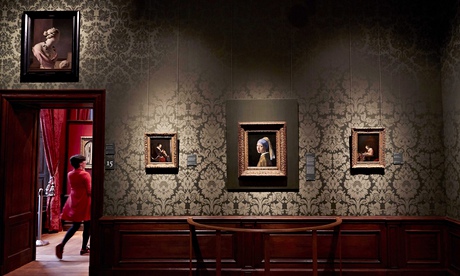
The young woman painted by Johannes Vermeer in about 1665 has never looked better. Her perfect skin and lively eyes, as bright as her famous earring, are exquisitely lit as she parts her lips to say – what?
The Girl with a Pearl Earring's wordless utterance hints at an erotic come-on that historians cannot explicate but novelists and filmmakers can't help guessing at. Was she Vermeer's lover? His obscure object of desire?
Now this seductive painting in which Vermeer (usually such a restrained, cool, cautious artist) seems to indulge a secret passion, has a new, or rather reinvented, home. The masterpiece is better lit, better hung and more elegantly surrounded than ever before at the refurbished and modernised Mauritshuis in The Hague, which rivals Amsterdam's Rijksmuseum as the greatest collection of Dutch art in the world.
If the Rijksmuseum is bigger, it is the Mauritshuis collection that owns some of the most iconic Dutch masterpieces, from The Girl with a Pearl Earring to The Goldfinch by Carel Fabritius – yes, that goldfinch, the painting that inspired the recent bestseller by Donna Tartt whose main character is obsessed with this picture. Visitors flocked to an exhibition of highlights from the Mauritshuis in New York last year to see the bird that appears on the cover of the book.
Now the painting has its own fenced-off little display in The Hague as a celebrity painting – and what a brilliant work it is, the feathers of the goldfinch painted in broad, free, almost abstract dollops of colour.
Yet however much glitz and glamour surrounds some of the paintings here, the Mauritshuis is above all a collection to lose yourself in, as you drift among the painted polders and anatomy theatres of the 17th-century Dutch Republic.
The museum's refurbishment is dramatic and tasteful. It is clearly designed to turn a connoisseurs's collection into a pop destination, and it deserves to succeed at that. Its period treasure house of Dutch Golden Age art is now reached by a very modern approach. The new entrance is through a spacious underground lobby. One way leads to a stylish suite of cafes, shops and all the other facilities we expect nowadays. What does all this added modern swankery add to the art collection of the princes of Orange that is housed here? It gives the place a sense of occasion – and the cafe really is very nice.
But once you proceed past the new architectural prologue into the collection's home in the 17th-century house of Prince Johan Maurits, now immaculately restored and relit, the silent world of painting takes over. Rembrandt gazes back from what is probably his last self-portrait, looking exhausted and broken but seeming to possess an unsettling wisdom that puts me in my place. Women lay out huge strips of linen to bleach in the sun in a painting by Jacob Ruisdael that astonishingly manages to show the whole landscape around Haarlem with the lofty precision of a satellite photograph.
Dutch painters four centuries ago used experimental techniques that make their paintings precociously modern in our eyes. The brushwork of Frans Hals's Laughing Boy, painted in about 1625, is so casual and chaotic it seems almost drunken in its gleeful abandon. But most of all, these artists appear engrossed in a world of things. Working amid merchant wealth and the scientific revolution, they look relentlessly on reality, trying to fathom it. Paulus Potter portrays an enormous bull life size, in a giant canvas that teeters on surrealism. Traditionally, pictures this size were for recording battles. Potter gives historical scale to a farmer showing off a prize bull.
Rembrandt looks that bit deeper. His Anatomy Lesson of Dr Nicolaes Tulp contains a trap for the eye. Looking at the attentive faces of the men watching Tulp's lesson, your gaze is led irresistibly to the gory skinned arm of the grey corpse whose sinews and bones the anatomist is describing. The eye is drawn into a dark tunnel between the arm's exposed muscles – and into the body itself. Rembrandt leads the onlooker from the visible world to the invisible darkness within. What lies there?
You may as well ask what is going on inside all the houses of Delft whose sunlit rooftops Vermeer painted in about 1660 in his great View of Delft. Looking at his home town from its harbour, he ponders the image of the city gate reflected in still, deep waters. Clouds pregnant with rain or some other menace glide above. People meet on the shoreline, posed like dolls.
Beyond the brick walls whose every detail Vermeer mirrors in shadowed and sunlit passages of mottled paint, beyond blank windows, a city is going about its business. People must be pouring milk, reading letters and pursuing girls with pearl earrings. But we can't see them. What is Vermeer's painting about? It seems to suggest the impossibility of doing justice to life's plenitude in art. It is a painting about the inadequacy of painting.
The relaunched Mauritshuis exquisitely combines the conveniences of a modern museum with the character of a collection and house that go back to the Dutch Golden Age itself. Yet the true reason to come here is to encounter some of the world's most profound works of art – and they never change.

